TEAMWORK INFLUENCES THE TEAM’S EFFICIENCY OF CHULARAT HOSPITAL GROUP: EXPLORATORY FACTOR ANALYSIS
Keywords:
teamwork, exploratory factor analysis, teamworkfactor of teamwork, Chularat HospitalAbstract
The purposes of this research were to analyze factors that influence the team’s efficiency using an exploratory factor analysis among the doctors, nurses, and hospital staffs in Chularat Hospital Group. The
sample was 317 people who work in the hospital including doctors, nurses, and staffs. The research instrument was developed by documentary research which bases on the concepts and theories of effective teamwork. Cronbach’s alpha internal consistency was used to estimate for reliability of the scale. The exploratory factor analysis was examined to determine the number of factors. The result indicated that there are six factors influencing team’s efficiency which are; open communication, team unity, trust, team relationship, respect, and participation. All factors combined can predict variance of team’s efficiency is 79.569 percent.
References
จินนะรัตน์ ศรีภัทรภิญโญ. (2535). การบันทึกทางการพยาบาล. วารสารกองการพยาบาล, 25, หน้า 38-41.
จุฬาภรณ์ โสตะ และคณะ. (2543). การมีส่วนร่วมของประชาชนและองค์การบริหารส่วนตําบลในการ บริหารจัดการเพื่อการออกกําลังกาย. ขอนแก่น: มหาวิทยาลัยขอนแก่น.
ชาญชัย อาจินสมาจาร. (2553). ทักษะภาวะผู้นำ. กรุงเทพฯ: มัลติอินฟอร์เมชั่นเทคโนโลยี.
ณัฏฐพันธ์ เขจรนันทน์ และคณะ. (2545). การสร้างทีมงานที่มีประสิทธิภาพ. กรุงเทพฯ: เอ็กซ์เปอร์เน็ท.
นิรมล ปลั่งพงษ์พันธ์. (2539). เจาะไอเดียนักบริหารยุทธศาสตร์การพัฒนาทรัพยากรมนุษย์ภาคราชการ.
จุลสารพัฒนาข้าราชการพลเรือน, 3(1), หน้า 26-29.
เนตร์พัณณา ยาวิราช. (2546). การจัดการสมัยใหม่. กรุงเทพฯ: เซ็นทรัลเอ็กซ์เพรส.
พรรณราย ทรัพยะประภา. (2548). จิตวิทยาประยุกต์ในชีวิตและในการทำงาน. กรุงเทพฯ: จุฬาลงกรณ์
มหาวิทยาลัย.
รัตติกรณ์ จงวิศาล. (2550). มนุษยสัมพันธ์: พฤติกรรมในองค์กร. กรุงเทพฯ: มหาวิทยาลัยเกษตรศาสตร์.
วราภรณ์ ตระกูลสฤษดิ์. (2549). การทํางานเป็นทีม. กรุงเทพฯ: ศูนย์ส่งเสริมวิชาการ .
วิรัช สงวนวงศ์วาน. (2551). การจัดการและพฤติกรรมองค์การ (พิมพ์ครั้งที่ 2). กรุงเทพฯ: เพียร์สัน
เอ็ดดูเคชั่น อินโดไชน่า.
สงวน ช้างฉัตร. (2553). พฤติกรรมองค์การ. พิษณุโลก: สถาบันราชภัฏพิบูลสงคราม.
สุนันทา เลาหนันท์. (2554). การสร้างทีมงาน (พิมพ์ครั้งที่ 4). กรุงเทพฯ: แฮนด์เมดสติกเกอร์แอนด์ดีไซน์.
สุเมธ แสงนิ่มนวล. (2544). ทําอย่างไรจึงจะเป็นนักบริหารชั้นยอด. กรุงเทพฯ: บุ๊คแบงก์.
Krejcie, Robert V., & Morgan, Daryle W. (1970). Determining sample size for research activities.
Educational and Psychological Measurement, 30(3), pp. 607-610.
McAllister, Daniel J. (1995). Affect-and cognition-based trust as foundations for interpersonal
cooperation in organizations. Academy of Management Journal, 38(1), pp. 24-59.
Na-Nan, K. (2016). Performance management system of SMEs in Thailand. International Journal of
Economics Research, 13(4), pp. 1641-1658.
Na-Nan, K., Chaiprasit, K., & Pukkeeree, P. (2017). Influences of workplace environment factors on employees’ training transfer. Industrial and Commercial Training, 49(6), pp. 303-314.
Parker, G. M. (1990). Team players and team work: The new competitive business strategy. San
Francisco, CA: Jossey-Bass.
Downloads
Published
Issue
Section
License
บทความทุกบทความเป็นลิขสิทธิ์ของวารสารวิชาการศรีปทุม ชลบุรี



